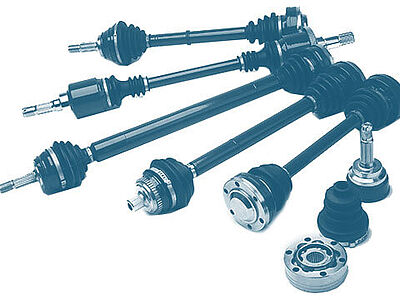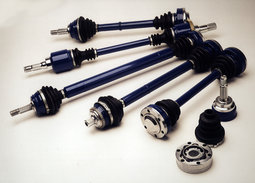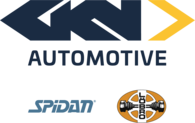Drive shaft

The function of the drive shaft is to transfer the engine torque from the gearbox or differential to the wheels. It must also compensate for all variations in angle or length resulting...
Function
The function of the drive shaft is to transfer the engine torque from the gearbox or differential to the wheels. It must also compensate for all variations in angle or length resulting from manoeuvring and deflection for perfect synchronisation between joints.

Drive shafts for cars with front wheel drive consist of the outboard fixed joint, the inboard constant velocity joint and the connecting shaft. They also include elements such as the anti-lock system ring and the torsion damper. The basic design of the outboard fixed ball joint, the constant velocity joint, dates from the 1930s.
In most cases the inboard CVJ takes the form of a slip joint to allow the drive shaft to follow the movements of the wheel suspension. At the front axle (leading axle) the outboard joint must transfer the torque effectively through a large angle (up to 52 degrees). At the rear axle the angles of the outboard joints are considerably smaller.
Constant velocity drive shafts are exposed to maximum stress all the time that the vehicle is in operation. Alongside the extremely significant displacement angles and translational movement, the joints and bellows must be able to withstand temperatures of between minus 40 and plus 120 °C as well as speeds of up to 2800 rpm. In order to transmit the required torque in all engine speed and velocity ranges with reliable constancy (ideally throughout the entire service life of the vehicle), all components must be maintenance-free.
Safety
Drive shafts and constant velocity joints are components of modern cars, which demand maximum safety.
Most problems with the drive shaft manifest themselves in the form of knocking noises when driving round tight corners, accelerating, or when the suspension is being compressed and extended. To avoid putting the safety of the vehicle at risk, make an appointment with a specialist garage if any of these symptoms occur. Specialists can be relied upon to detect damage to the drive shaft and provide the necessary assistance in good time.
Depreciation
To maximise their service lives, drive shafts must be inspected regularly at a specialist garage. Such inspections are carried out as part of the regular service checks prescribed by vehicle manufacturers. Another good time to check the condition of drive shafts is when switching from summer to winter tyres or vice versa.
Environmental protection
Both brand new replacement drive shafts for passenger vehicles and professionally reconditioned drive shafts are available on the market. When used drive shafts (most of which will have been damaged) are reconditioned, the old parts are taken back from vehicle garages for professional recycling in special production plants in accordance with the standards set for original equipment.
As part of this process, all usable steel parts are reused. The old shafts are inspected, taken apart, cleaned, remachined and then put back together for the car repairs market. Other materials resulting from the reconditioning process (old grease, metal chips or worn steel parts, for example) are disposed of in the correct and proper way in accordance with applicable environmental guidelines. Recycling significantly reduces the consumption of both raw materials and energy and makes a significant contribution to active protection of the environment.
Downloads
Here you can find all available downloads for the topic "Drive shaft":
All file downloads:




